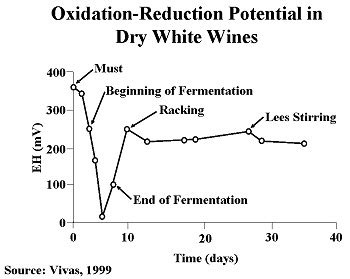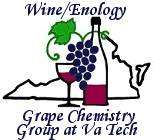Enology Notes
Enology Notes #129, April 30, 2007
To: Regional Wine Producers
From: Bruce Zoecklein, Head, Enology-Grape Chemistry Group, Virginia Tech
Subject: New Edition: Winery Planning and Design CD; Advanced Technical Meeting: Wine Longevity; Copper, Glutathione, and Wine Longevity; Hyper-Reduction and Wine Longevity; Thank You.
1. New Edition of Winery Planning and Design CD Available. Edition 13 is an expanded CD that covers the topics listed below. Each subject area is reviewed in a simple-to-read outline form.
The Winery Planning and Design CD, Edition 13, is available through Practical Winery and Vineyard magazine. Email them at , or call (415) 479-5819.
CD Edition 13 Subject Areas:
Winery Business Planning
- Elements of a Successful Business Plan
- Tips for a Successful Executive Summary
- Small Business Development Center Business Plan Outline
- Business Plan Worksheet
- Writing a Business Plan: A guide for small wineries – NEW
- Small Winery Investment and Operating Costs – NEW
- Winery PR and PR Resources – NEW
Winery Economics
- The Economics of Various Size Wineries, and Economies of Scale
- Cash Flow Review
- Starting a New Winery
- Planning for Profitability – NEW
- Winery Public Relations – NEW
- Public Relations Resources – NEW
Winery Design
- Winery Design Considerations
- Winery Layout
- Winery Facility Design, Concepts and Case Studies – NEW
- Construction Process Map – NEW
- Winery Tasting Room – Expanded
Winery Equipment
- Equipment Considerations
- Equipping a Small Winery
- Fermentation and Storage Vessel Considerations
- Wine Caves – Expanded
- Gravity Flow Winery Designs – Expanded
Examples of Winery Designs
- Winery Architecture
- Winery Designs and Case Studies – NEW
- Winery Tasting Room Design
Green Wineries and Sustainable Winegrowing
- Winery Sustainability Options – Expanded
- Saving Energy and Water – NEW
Winery Refrigeration
Winery Water Requirements
- Winery Wastewater Treatment – NEW
The Winery Laboratory and HACCP Planning
Winery Legal Issues
2. Advanced Technical Meeting: Wine Longevity. A meeting to discuss the issues of wine longevity will be held at Horton Cellars, Monday, May 21 from 1:00 PM to 4:30 PM.
This program is for Virginia commercial wine producers. Pre-registration is required. The program fee is $15.00, payable to Virginia Tech Foundation.
Send registration fee to: Terry Rakestraw, Department of Food Science and Technology (0418), Virginia Tech, Blacksburg, VA 24061. For additional information, write .
Renowned international consultant Dominique Delteil (formerly Director of France’s ICV and currently a consultant for Lallemand, Inc.) and I will lead a discussion on wine longevity, and the factors impacting longevity.
Longevity can be defined as the time a wine maintains its market goals.
This workshop program will include discussions on the impact of winemaking practices on longevity. Subject areas include the following:
- Grape aroma maturity
- Color and tannin maturity
- Vine stress, ATA (atypical aging)
- Yeast nutrition, including nitrogen and oxygen nutrition
- Nitrogen and oxygen additions, including macro- and microoxygenation, and délestage
- Yeast and MLF strains
- Non-soluble solids in the fermentor
- Impact of copper
- Processing variations, including hyper-reduction
- Redox buffers, and antioxidants, including sulfur dioxide, ascorbic acid, lees, and glutathione
Each of these topics has been discussed in previous editions of Enology Notes. For information on a particular subject, go to www.vtwines.info. Click Enology Notes, then Enology Notes Index.
3.Copper, Glutathione and Wine Longevity. As previously reported (Enology Notes #46, 85, 93, 101, 102, 111, 112, 113), copper is a strong inorganic oxidative catalyst. As such, copper in the must, from late-season Bordeaux mix vineyard sprays or any other source, can lower the longevity of white wines.
Copper inactivates glutathione. Glutathione is a polypeptide produced by the grapevine, and by yeast at the end of fermentation. It is a strong antioxidant and helps to stabilize aroma components. A low level of glutathione results in juice that oxidizes quickly, going very rapidly from green to brown
Glutathione plays an important role as an oxidative buffer, thus impacting wine longevity. Lees contain glutathione, one reason why lees storage keeps wines from undergoing oxidative degradation.
The following are important relationships regarding glutathione:
- There is a positive correlation between glutathione and the freshness and longevity of white wines.
- There is a positive correlation between the concentration of glutathione in the must and concentration in the young wine.
- There is a positive correlation between the juice free amino nitrogen (FAN) concentration and the glutathione concentration at the end of alcoholic fermentation.
- There is an inverse relationship between copper concentration in musts and wines, and glutathione
- Minimizing the loss of glutathione is a key to making white wine and optimizing wine longevity.
The management of native grape and yeast glutathione is an important step for maximizing white wine aroma/flavor and maintaining wine longevity.
4. Hyper-Reduction and Wine Longevity. Previous editions of Enology Notes have discussed oxidation-reduction potential (redox) in the context of bottle closures and wine aging. As a gross generalization and for winemaking purposes, redox can be thought of as the quantity of oxygen. As the figure below indicates, after fermentation begins, the redox potential declines significantly. During this period, wine oxidation is limited. The problem occurs both before and after fermentation, when the higher redox potential allows for juice or wine oxidation.
Enology Notes # 101 also discussed redox potential of juice during the early stages of processing, and the issue of fermenting green vs. brown juice.
Blanketing juice with carbon dioxide during pressing may help to keep the juice green, and keep the oxidation-reduction potential low, thus limiting aroma/flavor degradation. As stated in the previous edition, this can assist in minimizing oxidative degradation of certain labile aroma/flavor compounds.
The debate regarding the importance of green vs. brown juice relates both to style and variety. The importance of fermenting green juice with limited oxidative degradation is referred to as hyper-reduction.

As indicated in Enology Notes # 101, many of the volatile sulfur compounds important to Sauvignon blanc varietal character, for example, are easily oxidized. Therefore, protection from the impact of molecular oxygen at berry breakage makes sense. The same is true with many other white varieties.
Lowering the molecular oxygen exposure (and the addition of antioxidants, such as ascorbic acid and sulfur dioxide) helps to lower the redox potential and limit oxidative degradation. This is a primary reason why some winemakers blanket juice with carbon dioxide at the press. Ascorbic acid addition helps to bind molecular oxygen. Ascorbic acid is a very good oxygen scalper, acting much more rapidly than sulfur dioxide.
There is an age-old debate regarding the merits of brown vs. green juice in the fermentor. As new research comes to light, we find that the dichotomy between green vs. brown relates not simply to style, but also to variety and longevity issues.
For example, maximizing passion-fruit notes in Sauvignon blanc requires the limitation of oxidative degradation of fruit volatiles. Indeed, this is a primary reason why some add ascorbic acid to the juice and attempt to limit oxidation via carbon dioxide blanketing at the press.
5. Thank You. The world-wide response to the tragedy at Virginia Tech has been overwhelming. I want to again express our thanks to so many who expressed condolences for this senseless act of violence.
“[T]he mindless menace of violence in America…again stains our land and every one of our lives. It is not the concern of any one race. The victims of violence are black and white, rich and poor, young and old, famous and unknown. They are, most important of all, human beings whom other human beings loved and needed.
“No one – no matter where he lives or what he does – can be certain who will suffer from some senseless acts of bloodshed. And yet it goes on and on in this country of ours. Why? What has violence ever accomplished? What has it ever created?”
“Yet we seemingly tolerate a rising level of violence that ignores our common humanity and our claims to civilization alike… This much is clear: violence breeds violence… and only a cleansing of our whole society can remove this sickness from our soul.”
“[W]e cannot vanquish violence with a program, nor with a resolution. But we can perhaps remember, if only for a time, that those who live with us are our brothers, that they share with us the same short moment of life; that they seek, as do we, nothing but the chance to live out their lives in purpose…happiness [and] satisfaction…Surely this bond of common faith, this bond of common goals, can begin to teach us something.”
Robert F Kennedy.
![]()
Subscription to Enology Notes. All past Enology Notes newsjournals are posted on the Enology-Grape Chemistry Group's web site at: http://www.vtwines.info/.
To be added to (or removed from) the Enology Notes listserve send an email message to with the word "ADD" or "REMOVE" in the subject line.
Dr. Bruce
Zoecklein
Professor and Enology Specialist Head Enology-Grape Chemistry Group
Department of Food Science and Technology, Virginia Tech
Blacksburg VA 24061
Enology-Grape Chemistry Group Web address: http://www.vtwines.info/
Phone: (540) 231-5325
Fax: (540) 231-9293
Cell phone: 540-998-9025
Email:
